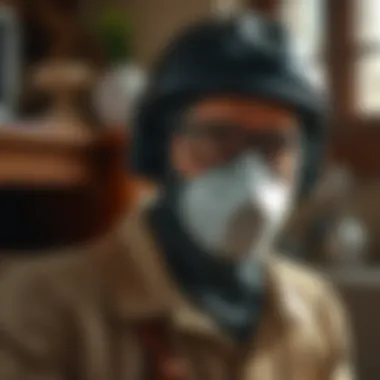Orkin Consultation: Your Guide to Pest Management


Intro
Pest management can feel like navigating a maze, especially when it comes to understanding the Orkin consultation process. This isn't just about getting rid of unwanted critters; it's about creating a strategic plan tailored for your specific environment. Homeowners and housewives alike often find themselves grappling with the complexities of pest infestations, not to mention the sheer variety of methods available to combat these nuisances.
The journey typically starts with a professional assessment. The goal? To identify the pests lurking in your home and analyze the extent of the infestation. This sets the stage for a proactive strategy tailored to your needs. Understanding the pest landscape is crucial, and that’s where effective consultation comes into play. Through this comprehensive guide, we'll unfold the layered intricacies of the Orkin consultation, shedding light on every facet involved in effective pest management.
Understanding Pests
Definition of Pests
Pests are more than just unwelcome visitors; they are organisms that can cause harm or nuisance. From the classic rodents and insects to the less visible organisms like mold and mildew, every pest poses a different challenge. The unique characteristics of each pest necessitate specific approaches to control, making proper identification a cornerstone of effective pest management.
Importance of Pest Identification
Knowing your enemy is half the battle. The first step in the Orkin consultation involves identifying the type of pest. Each pest has different habits, life cycles, and potential damage it can inflict. For example, termites might cause structural damage over time, while ants can invade food supplies. Proper identification is essential for strategizing a targeted attack, thus avoiding the risk of applying ineffective treatments that waste time and money.
"Effective pest management begins with understanding the nature of your infestation."
Identifying pests early not only helps in saving costs but also ensures a more effective and eco-friendly treatment approach. If you ignore a pest issue, you could be in for a rude awakening when it transforms from a minor annoyance to a full-blown headache. Therefore, emphasizing vigilance and professional assessments should be at the forefront of your pest management strategy.
Prevention Techniques
Home and Garden Preventative Measures
Once you've tackled the identification phase, the focus shifts to prevention. Keeping your home and gardens free of pests is all about proactive measures. Simple tactics like sealing cracks and crevices, keeping food stored properly, and maintaining cleanliness can go a long way. Take special care to inspect plants and outdoor furnishings as pests find these areas inviting.
Seasonal Prevention Tips
Each season poses unique challenges for pest management. For instance:
- Spring: Inspect your home for winter damage that can allow entry for pests.
- Summer: Focus on outdoor areas, ensuring that trash is disposed of regularly and that standing water is eliminated to prevent mosquitoes.
- Fall: Watch for rodents seeking warmth; potential entry points should be sealed.
- Winter: Maintain indoor insulation and firewood storage away from your home.
Being aware of these seasonal changes can make a significant difference in your pest control efforts. Orkin consultants can offer tailored advice based on the specific challenges presented by the weather changes in your area.
Eco-Friendly Pest Control Solutions
Overview of Sustainable Practices
In recent years, the shift to eco-friendly pest control has gained momentum. The awareness of the negative impact traditional chemicals has on health and environment has sparked interest in sustainable practices. Orkin employs integrated pest management (IPM) strategies, focusing on preventive practices that reduce the need for pesticides.
Natural Remedies and Their Effectiveness
While not every pest issue can be resolved with home remedies, some natural solutions have proven effective. Consider using:
- Diatomaceous Earth: A natural abrasive that can help eliminate crawling insects.
- Essential Oils: Certain oils, like peppermint or tea tree, act as natural repellents.
- Boric Acid: Effective against ants and cockroaches when used properly.
Though these methods may not replace professional intervention, they can be integrated into your routine as part of a larger pest management strategy.
By using Orkin’s expertise along with your own preventive tactics and eco-conscious methods, you can cultivate a pest-free environment that sets the stage for lasting peace of mind.
Preamble to Orkin Consultation
When it comes to keeping your home free from pests, the Orkin consultation stands out as a pivotal step in the pest management journey. Understanding this consultation process can empower homeowners, shedding light on the professional measures they can take against infestations.
The initial meeting not only addresses existing pest issues but also lays the groundwork for a robust strategy tailored to the unique needs of each property. Engaging with Orkin means tapping into a reservoir of expertise, which is critical when you consider the myriad of pests homeowners might encounter—from ants and cockroaches to more significant concerns like termites.
Orkin’s consultations are built around the premise that knowledge is power. By intricately evaluating a property, consultants can identify hot spots and the conditions that foster pest infestations. This is where the real benefit lies. Rather than just treating the symptoms of a pest problem, a thorough consultation looks at the root causes, offering a roadmap to long-term pest control success.
Another aspect worth considering is the evolving landscape of pest management, particularly with the rise in pest resistance to traditional treatments. A professional consultation not only provides insights into what’s currently affecting your home but also equips you with the latest in pest management techniques and products. As a homeowner, understanding these advancements can shift your approach from reactive to proactive.
Moreover, the consultation process also saves you time and effort. Understanding exactly what you’re up against can eliminate unnecessary trial and error with DIY pest control approaches that may not be effective. This aspect is particularly appealing for busy individuals or families who may not have the luxury of time to experiment with multiple products or methods.
"Investing time in a consultation today can save headaches tomorrow."
So, getting a handle on what an Orkin consultation entails is an essential step for any homeowner. Whether you’re currently dealing with a pesky infestation or just want to take preventative measures, this consultation opens the door to informed decisions. Getting to know the intricacies of this process will ultimately safeguard your home and enhance your quality of life.
The Purpose of a Pest Control Consultation
When it comes to maintaining a healthy living environment, the role of pest control consultations can't be overstated. Many homeowners often underestimate just how vital these consultations are in the grand scheme of pest management. A well-executed consultation lays the groundwork for effective interventions, ensuring that any infesting critters are dealt with efficiently and sustainably.
Identifying the Necessity for Professional Intervention
So, when should one bite the bullet and call in the professionals? Well, think of it this way: a few bugs wandering about may seem harmless, but if left unchecked, they can balloon into a full-blown infestation quite rapidly. It’s essential to recognize signs that might indicate the need for expert help.


For example, if you have noticed an uptick in unwelcome visitors like cockroaches or rodents, it’s time to wave the red flag.
- Unusual smells: Pest infestations often carry a distinct odor that could hint at underlying issues.
- Seeing droppings: This clear indicator can be hard to ignore.
- Signs of structural damage: Such as gnaw marks or holes in walls and flooring can be a cry for help.
Moreover, sometimes, folks may not even recognize when a pest problem has sprouted. For instance, termite infestation often goes unnoticed until significant damage has occurred. Professional consultations can give homeowners peace of mind by identifying these threats early, preventing costly repairs down the line.
Understanding Common Pest Issues
Taking a step back, let’s look closer at common culprits that usher in a need for consultation. Not all pests are created equal; each type brings its own set of challenges.
- Ants: Species like carpenter ants can be particularly troublesome as they often damage wooden structures. They don’t just invade your pantry; they might also be munching away at your house.
- Bed Bugs: Known for their resilience, these pests can turn a peaceful night into a sleepless nightmare. Their presence may not always be apparent until it’s too late.
- Rodents: Rats and mice are not just a nuisance; they can also carry diseases. Their common entry points can often go unnoticed without a thorough inspection.
- Termites: Estimated billions in property damage arise annually thanks to these wood-eating pests. Early detection through a professional consultation can save you a hefty dime.
Having an understanding of these common pest issues will help homeowners make informed decisions during their consultation. Armed with this knowledge, they can engage in more meaningful conversations with pest management professionals, ultimately aiding in prompt and effective pest control solutions.
The Initial Steps to Schedule a Consultation
Scheduling a consultation for pest control is a crucial first step in addressing any pest issues one may have. This process is not merely about making a phone call or sending an email; it encompasses a thoughtful approach to selecting a reliable service that effectively meets your needs. Taking these initial steps seriously ensures that you have a clear path toward a pest-free environment, allowing homeowners to regain their peace of mind.
There’s something to be said about the importance of finding the right pest control provider. It’s akin to finding a good doctor; you want someone who is knowledgeable and has a proven track record. The choices you make during this phase can significantly impact the outcomes you experience, from the assessment of your pest situation to the treatment options that may be available.
Choosing the Right Service Provider
When it comes to pest management, not all service providers are created equal. Researching and comparing different companies can save one from a lot of hassle down the road. Here are some factors to consider when selecting a provider:
- Experience: Look for companies with a history of effective pest management. Orkin, for example, boasts over a century of experience, with trained professionals who know their way around different pests.
- Certifications and Licenses: Ensure that the pest control company you choose is licensed and certified in your area. This not only guarantees that they meet safety and environmental standards but also gives you peace of mind.
- Reputation: Reviews and testimonials from previous clients can provide insight into the reliability and effectiveness of a service. Websites like Reddit and Yelp offer user-generated feedback that can be quite telling when it comes to customer satisfaction.
- Methods and Tools: Different companies use various techniques and agents to control pests. Inquire about what methods they utilize and if they take an integrated pest management approach.
All these factors will guide you in picking the right provider who fits your specific needs, giving you confidence in your choice to address pest issues.
Contact Methods for Consultation Requests
With your service provider chosen, the next step is getting in touch. There are multiple ways to reach out, each offering its own benefits:
- Phone Calls: Sometimes, there’s no substitute for a good old-fashioned call. Speaking directly with a representative can provide immediate answers to any pressing questions you may have, fresh from the horse's mouth.
- Websites: Many companies, including Orkin, have user-friendly websites where you can request a consultation online. This method often allows you to fill out specific details regarding your pest problem, which can expedite the process.
- Social Media: Platforms like Facebook can also be valuable for reaching out. Companies often respond to inquiries made through social media faster than traditional channels.
- Email: Sending an email can be beneficial if you prefer to have a written record of your correspondence. It allows you to communicate detailed concerns without rushing, and you can follow up easily.
Each of these contact methods serves as a gateway to effective communication with pest control services, making it easier for homeowners to embark on their pest management journey.
Preparing for the Consultation Visit
Preparing for a pest control consultation with Orkin is more than just a routine task—it sets the stage for effective pest management. When individuals take the initiative to prepare adequately, they can expect a consultation that is tailored to their unique situations. This preparation can significantly enhance the overall effectiveness of the pest control approach.
Essential Information to Provide
Before the consultant arrives, homeowners should gather as much relevant information as possible. This can include:
- Description of the Problem: A detailed account of what pests have been spotted, where they have been seen, and any damage observed.
- Previous Pest Control Efforts: Mention any prior pest control services used, along with the products that were applied, as this helps the consultant understand what strategies have been employed in the past.
- Home Environment Details: Notes on the layout of the home, such as common entry and exit points, as well as the surrounding environment. This can include gardens, garbage disposal areas, and nearby water sources that may attract pests.
- Lifestyle Factors: Information about household routines, such as food storage practices and cleaning schedules, can also be pertinent. These habits might be contributing factors to infestations or areas ripe for preventative action.
Providing this information ensures that the consultant can develop a comprehensive understanding of the pest issues at hand. It also saves time during the visit, allowing for a more targeted approach to pest management.
Setting Expectations for the Visit
Setting clear expectations for the consultation visit can alleviate stress and foster a more productive dialogue between the homeowner and the pest control expert. Here are a few key points to consider:
- Duration and Structure: Consultations can vary in length, but homeowners should expect anywhere from an hour to several hours depending on the complexity of the situation. Knowing this helps in planning accordingly.
- Assessment Process: Expect the consultant to conduct a thorough inspection of the property, including both indoor and outdoor areas. This will involve looking into potential hiding spots and assessing environmental factors that might be inviting pests in.
- Communication Etiquette: Homeowners should be prepared to ask questions and discuss their specific concerns openly during the meeting. Understanding that this is a collaborative effort can lead to better outcomes.
- Next Steps: It's also wise to inquire about follow-up actions post-consultation. Discuss what sort of treatment plans might be proposed and how implementations will be managed.
By being prepared and clear about expectations, homeowners can transform a seemingly daunting consultation into a well-organized and insightful experience. This groundwork lays the foundation for effective pest management, ensuring that all parties involved are aligned and informed in the process.
What to Expect During the Consultation
Understanding what to expect during a pest control consultation can greatly alleviate any apprehensions and set the stage for effective treatment solutions. At this juncture, the importance of the meeting is often underscored by the sheer variety of pest issues homeowners may encounter throughout the year. Knowing how the consultation unfolds allows homeowners to prepare mentally and practically to engage with the pest control specialist about their concerns.
During the consultation, the Orkin representative will primarily focus on examining the property and gathering crucial information to develop a tailored pest management strategy. This isn’t merely a cursory glance—it's a thorough investigation designed to pinpoint not only visible signs of pests but also potential breeding grounds. The benefits here are twofold. First, it provides a clearer understanding of the unique challenges posed by your living environment. Second, it empowers the consultant to make informed recommendations based on your specific situation and needs.
Inspection and Assessment Techniques
The inspection and assessment phase serves as the backbone of the consultation process. Orkin experts typically employ multiple inspection techniques, adeptly combining visual inspection with more advanced tools like moisture meters and infrared cameras. These gadgets go beyond mere surface evaluations, allowing the consultant to identify hidden infestations in walls, attics, and basements.
Having a systematic approach is crucial. For instance, they might follow these steps:
- Visual Walkthrough: A thorough examination of both the interior and exterior areas of the home, paying extra attention to corners, cracks, and crevices where pests might be lurking.
- Identification of Entry Points: Noting all potential entry points—like gaps around windows or doors—can reveal how pests are gaining access to your home.
- Assessment of Conditions: Evaluating conditions conducive to pest infestations, such as stagnant water sources or clutter that could provide nesting grounds, is also critical.
By involving advanced tools and thorough techniques during the assessment, the Orkin consultant ensures that no stone is left unturned. Whether it’s discerning the difference between a carpenter ant and a termite or locating areas with high moisture content that could attract pests, the finely tuned skills of inspectors are paramount.
Consultant’s Evaluation Process
Once the inspection wraps up, the consultant moves into the evaluation process, where their expertise comes into play more prominently. This part is all about marrying the information gathered during the inspection with your specific concerns and home environment. Here, the consultant engages with you, asking pertinent questions to gain insight into what you’ve observed. This interaction is essential, as it comes from your unique perspective living in the space.


The evaluation includes several key elements:
- Review of Findings: The consultant will take the time to communicate their findings clearly. This includes xplaining what they discovered, emphasizing both urgent pest issues and lesser concerns that may require attention later.
- Recommended Solutions: Based on the assessment, the professional will provide tailored recommendations, outlining both immediate actions required and long-term strategies for prevention.
- Potential Costs: An honest appraisal of what the pest control measures will cost is also part of this evaluation. The consultant strives to ensure you understand the rationale behind each suggested action.
"The greater the understanding a homeowner has about the pest control process, the better prepared they are to make informed decisions about protecting their home."
Being prepared for the consultation process not only sets the foundation for effective pest management but also establishes an ongoing partnership between the homeowner and the pest control experts. Through thorough inspection techniques and the consultant's evaluation process, you will walk away with a comprehensive understanding of your pest situation—both the immediate and future strategies—and a renewed sense of confidence in maintaining a pest-free environment.
Understanding Treatment Options Offered by Orkin
Understanding the treatment options that Orkin provides is crucial for making educational decisions about pest management. Homeowners often feel overwhelmed by the variety of choices available, and knowing what tools are at your disposal can make a significant difference. Orkin’s approach combines both chemical and non-chemical methods to address pest problems, which is vital for achieving a balance between effectiveness and environmental safety.
Chemical vs. Non-Chemical Solutions
Orkin offers a range of chemical solutions tailored to target specific pests efficiently. These are typically fast-acting and can provide immediate relief from infestations. For instance, products such as imidacloprid or pyrethroids are designed for insects like termites or bed bugs. Chemical methods often come with rigorous safety protocols, ensuring that the risks are minimized when applied correctly.
On the flip side, non-chemical options have been gaining traction. These include methods such as heat treatment and boric acid, which require careful planning and execution. Non-chemical methods can be attractive for householders cautious about introducing substances into their environments. They often emphasize long-lasting control without chemical residues.
Ultimately, the choice between chemical and non-chemical solutions depends on several factors:
- The type of pest affecting your home.
- The severity of the infestation.
- Health considerations of the residents, including pets.
It’s important to have a candid discussion with your Orkin consultant about these options, weighing the pros and cons based on your unique situation.
Integrating Prevention Strategies
After identifying an appropriate treatment plan, integrating prevention strategies is equally important in maintaining a pest-free home. Orkin emphasizes that proactive measures can save you time, money, and stress in the long run. Prevention is not just about treatment; it involves continuously assessing your home’s vulnerabilities.
Here are some strategies homeowners can embrace:
- Regular Inspections: Schedule periodic checks of your property. Small issues can become big problems if left unchecked.
- Sealing Entry Points: Ensure that cracks and crevices are sealed. Use caulk or other materials to close off paths that pests might take.
- Proper Landscaping: Maintain plants and shrubs away from the building. Overgrown greenery can create perfect habitats for pests.
- Attic and Basement Maintenance: Keep these areas dry and clutter-free. Moisture attracts pests, and piles of discarded items can serve as nesting grounds.
Incorporating these practices creates a robust line of defense against pests, making it less likely that an infestation will take hold again.
As you think about treatment options, consider that the ideal approach combines immediate action with long-term prevention. Remember, it's not just about getting rid of the pests today; it's about ensuring they don’t come back tomorrow.
The Role of Technology in Orkin’s Pest Control Solutions
In today’s age, where innovation is a driving force behind effectiveness, pest management is no exception. Orkin leverages advanced technology to bolster its pest control solutions, ensuring that interventions are not only effective but precise and efficient. With the help of technology, pest control extends beyond mere reaction to infestations; it evolves into a proactive stance, preventing the issues before they escalate.
Innovative Tools and Equipment
The pest control landscape has changed dramatically over the years with the introduction of high-tech tools and equipment. One might wonder, what exactly does Orkin employ that sets its practices apart?
- Thermal Imaging Cameras: These devices help identify pest hotspots without invasive measures. For example, finding rodent infestations or moisture leaks where pests might thrive becomes easier. This technology allows Orkin professionals to pinpoint areas needing immediate attention, giving a clearer view than the naked eye.
- Smart Traps: Orkin often utilizes traps equipped with sensors that alert technicians about any captured pests. These traps not only reduce the need for frequent checks but also optimize the time response. Imagine being informed about a mouse trapped without setting foot in the area?
- Insect Monitors: By placing these monitors strategically around a property, Orkin can track movement patterns and identify the types of insects present. Having data on pest activity ensures that treatments are tailored specifically to the identified problems, rather than a blanket approach.
The integration of such tools signifies that pest management is a more calculated effort than ever, reducing chemical use and concentrating on what truly matters—the pests.
Data-Driven Decision Making
Employing technology doesn’t stop with tools; it also extends to the data gathered throughout pest management processes. Data-driven decision making is a game changer in the pest control saga.
- Analytics Platforms: Orkin maintains systems that track pest patterns and treatment effectiveness. This means that every consultation and treatment strategy is based on past data, streamlining future interactions. Essentially, past infestations inform future solutions, allowing for more targeted strategies.
- Customer Feedback Systems: Leveraging technology also means tapping into user experience. Orkin regularly collects feedback from clients post-treatment. This data not only informs whether a treatment was effective but also shapes future strategies and enhances customer service.
- Mapping and Predictive Modeling: Technology allows Orkin to visualize pest movement patterns. Using predictive models helps to foresee potential future infestations and consequently prepare accordingly. If data suggests a particular pest thrives in humid conditions, preventive actions can be put in place preemptively based on forecasts.
The integration of technology in pest control not only enhances accuracy but also significantly improves efficiency, saving homeowners time and money in the long run.
In the realm of pest management, the importance of adapting to a tech-driven world cannot be overstated. Orkin’s use of innovative tools and data analytics is instrumental in offering clients a pest-free environment, ultimately demonstrating the efficacy and necessity of professional pest control services.
Post-Consultation Follow-Up Procedures
Effective pest management doesn't end with the consultation itself; it continues through diligent follow-up procedures. Understanding the post-consultation process is crucial, as this is where the groundwork laid during the consultation can be translated into actionable results. Proper follow-up not only reinforces the relationship between the homeowner and the pest control provider but also ensures that any issues are addressed promptly and effectively.
Communication of Findings
Firstly, let's talk about the communication of findings. After the consultant has completed their inspection, it's vital that they relay their observations and recommendations clearly to the homeowner. This includes discussing the types of pests identified, the extent of the infestation, and the suggested treatment options. Providing this information in a straightforward manner builds trust and allows the homeowner to make informed decisions.
Here are some key aspects to consider when communicating findings:
- Clarity and Detail: Use plain language, avoiding jargon where possible. Detailed explanations help homeowners understand the situation better.
- Visual Aids: If applicable, including photographs or diagrams can make complex issues more tangible.
- Follow-up Questions: Encourage homeowners to ask questions and clarify points during this discussion. An open dialogue fosters better understanding and satisfaction.
“Communication is key to a successful pest management strategy. When homeowners are informed, they feel empowered.”
Implementing Recommended Actions
The second pillar in the follow-up process is implementing the recommended actions. It's one thing to provide a list of suggestions after the consultation, but actual implementation is where the rubber meets the road. Homeowners need to prioritize these actions within a timeframe that can effectively manage potential infestations.


Here’s a breakdown of how to approach implementing the suggestions:
- Establish a Timeline: Work with the pest control provider to establish when and how recommended actions can be taken. Setting deadlines helps maintain momentum.
- Regular Check-Ins: Frequent communication between the homeowner and pest control provider can ensure that every step is being executed properly.
- Documentation: Keeping records of actions taken and their outcomes allows both parties to track progress and make adjustments if necessary.
In summary, post-consultation follow-up procedures are not merely an afterthought; they are integral to a comprehensive approach in pest management. By prioritizing clear communication and diligent action implementation, homeowners can maintain their spaces effectively without the looming anxiety of infestations resurfacing.
Assessing Long-Term Pest Management Strategies
Understanding long-term pest management is not just about applying a fix and calling it a day. This section dives into why having a strategic approach is key and what makes an effective pest control program something you can rely on year after year. The bottom line is that a single pest issue rarely stands alone; it often represents a bigger picture that needs careful planning and evaluation.
Regular Monitoring and Maintenance
To keep pests at bay, it is essential to engage in regular monitoring and maintenance. Think of it like keeping an eye on your garden. You don't water it just once and expect it to flourish all year long. Here are ways you can incorporate monitoring into your routine:
- Scheduled Inspections: Orkin provides regular visits that aim to catch any potential issues before they become serious problems. You might not notice the gradual increase in pests, but pest control professionals will—it's their bread and butter.
- Ongoing Communication: Staying in direct contact with your pest control provider allows for rapid responses to any concerns you might have. A quick phone call or email can provide peace of mind and often quick solutions.
- Custom Maintenance Plans: Depending on the specifics of your home and the type of pests you're dealing with, a tailor-made plan can save you time, money, and a lot of headaches down the line. Whether you’re facing seasonal insects or rodents, these plans adapt as your needs change.
Regular maintenance also allows home and business owners to be proactive instead of reactive. Paying attention to the signs can set you on a correct path to a pest-free life. This is particularly valuable in areas highly prone to infestations.
Re-assessment of Pest Control Needs
The world around us is always changing, and so are pest behaviors. What worked last year might not give you the same results the next. This is where the importance of re-assessing your pest management needs shines through. It's crucial to routinely evaluate the effectiveness of your existing strategies so that they can be adjusted to fit any new challenges that may arise.
- Regular Reviews: Establish a schedule for reviewing your pest control strategy. Think of it like a yearly check-up with your doctor. This can help highlight any shortcomings and keep you ahead of possible infestations.
- Feedback Loop: Engaging with your pest control provider about what's working and what's not facilitates smarter decisions. Are you noticing more pests than usual even after treatments? Share that insight! This kind of dialogue can lead to adjustments that increase effectiveness.
- Changing Environment: New construction nearby or climate changes can influence pest behavior. Stay agile and adapt your practices accordingly. This continually evolving approach ensures you are not left in the dust.
"A stitch in time saves nine"—regular assessments and adjustments are your stitches, keeping you ahead of pest problems before they spiral out of control.
Common Myths About Pest Control Consultations
In the realm of pest management, numerous misconceptions can cloud judgment and deter homeowners from seeking professional help. It becomes crucial to untangle these myths to highlight the importance of pest control consultations. Understanding what’s true and what’s not can empower homeowners to maintain a healthier living environment.
Debunking Misconceptions
One of the most common myths surrounding pest control consultations is the belief that they are solely a thinly veiled marketing tactic designed to extract money from unsuspecting homeowners. The fact is, these consultations offer substantial value. They provide expert insights into specific pest problems that may not be apparent to a layman.
For instance, many people think that a self-assessment is sufficient to gauge pest infestations. However, in many cases, what’s visible to the naked eye doesn't tell the whole story.
"A trained eye can see the signs of pest activity that remain hidden to the untrained observer."
Consider the difference between spotting a couple of ants and understanding their entry points or nests. An expert consultation gives the homeowner an understanding of the broader ecosystem within and around their home.
Another misconception is that pest control professionals will always suggest a one-size-fits-all solution, opting for chemicals like a first resort rather than considering integrated pest management strategies. In reality, pest control is increasingly sophisticated, utilizing a variety of techniques customized based on the specific nature of the infestation.
Homeowners must realize that the initial consultation can be more about prevention and education than simply addressing a current issue. Just as you wouldn’t skip a car service simply because your vehicle is running well, neglecting pest inspections can lead to larger issues down the road.
Understanding the Value of Expertise
The value of enlisting pest control experts, such as those at Orkin, cannot be overlooked. Their training lends them a unique perspective and understanding that the average homeowner may simply lack. When experts assess a situation, they bring specialized knowledge about pest behaviors, life cycles, and the best treatment options tailored to different environments.
This expertise goes beyond mere pest identification; it encompasses the finer points of pest prevention. For homeowners who feel overwhelmed by the plethora of DIY solutions and products available, consulting an expert can clarify what methods are truly effective.
Moreover, it’s not just about ridding the home of pests. It’s about establishing a long-term management plan that ensures sustainability. Knowledge of potential vulnerabilities within the home, such as moisture levels conducive to termites or structural weak points, helps families protect their spaces effectively.
In summary, pest control consultations offer invaluable assessments that can lead to effective, customized treatment solutions tailored not only to eradicate pests but to enhance the overall quality of life for homeowners. The cost of these consultations pales in comparison to the potential expenses of dealing with a more serious infestation that spirals out of control.
By demystifying these common myths and recognizing the genuine worth of expert intervention, homeowners can take informed steps towards a pest-free living space.
Closure: The Importance of Professional Pest Control Consultations
When it comes to maintaining a pest-free environment, the role of professional pest control consultations cannot be overstated. This final section wraps up the essential themes presented throughout this guide, emphasizing the significance of engaging experts like Orkin to address and manage pest infestations thoroughly.
Benefits of Professional Consultations
Pest control is often seen as an act of immediate response, yet the real value lies in the proactive approach fostered by expert consultations. Here are several benefits that underscore the importance of investing in professional assessments:
- Thorough Evaluation: Experts possess the ability to conduct detailed inspections to identify pest issues that homeowners might overlook. From small signs of infestation to potential entry points, their trained eyes can catch what a layperson might miss.
- Customized Solutions: No two pest situations are identical. A professional consultation results in tailored strategies that address unique vulnerabilities in a home or business, allowing for more effective treatment plans that fit specific needs.
- Enhanced Safety: Many homeowners might be unaware of the most suitable treatments or the risks associated with improper chemical use. Professionals ensure the safety of the home environment by applying methods that minimize health risks to residents and pets alike.
A Wise Investment
While some may view pest control consultations as an unnecessary expense, it’s important to recognize it as an investment in your home’s safety and structural integrity. By effectively addressing pest issues early on, the costs associated with severe infestations—including property damage and health-related expenses—can be substantially reduced. This preventive measure not only safeguards your living space but can also enhance its overall value.
Long-Term Partnerships
Engaging with professionals establishes a long-term relationship that is advantageous for ongoing pest management. Regular follow-ups and maintenance consultations help in keeping pest problems at bay, transforming a reactive approach into a proactive lifelong strategy.
"It's much easier to prevent pests than to deal with an infestation once it's taken hold."
Finale
In summary, the importance of professional pest control consultations is profound. They bridge the gap between basic awareness of pest issues and informed, effective management strategies. By understanding the full scope of the pests affecting your environment, you empower yourself to make better decisions, ensuring a resilient, pest-free home for years to come. As highlighted throughout this guide, the consultation process offered by services like Orkin not only brings expertise and advanced techniques but also emphasizes the necessity of staying ahead in an area that could significantly impact the well-being of your family and property.
For further reading on pest management and techniques, explore resources from CDC, and EPA.



